BSc (Hons) Business Management Strategic Management Case Study
VerifiedAdded on 2023/01/06
|13
|3511
|63
Report
AI Summary
This report provides a comprehensive strategic management case study analysis of Sainsbury's, a major UK supermarket chain. It begins by defining strategic management and then assesses the processes used by organizations to determine their strategy, specifically focusing on Sainsbury's evaluation of its current strategic position, vision, mission, objectives, and gap analysis. The report then evaluates critical models and tools such as PESTLE analysis, SWOT analysis, and Porter's Five Forces, demonstrating how Sainsbury's utilizes these frameworks to understand its macro-environment, internal strengths and weaknesses, and competitive positioning. The application of these tools to Sainsbury's is explored in detail, providing a practical demonstration of how the company addresses political, economic, social, technological, legal, and environmental factors, along with its strengths, weaknesses, opportunities, and threats. The analysis also incorporates Porter's Five Forces to assess the competitive landscape. Finally, the report critically appraises the importance of change management, acknowledging the complexity of transformation processes, associated costs, risks, and the need for sustainability within the context of Sainsbury's strategic endeavors.
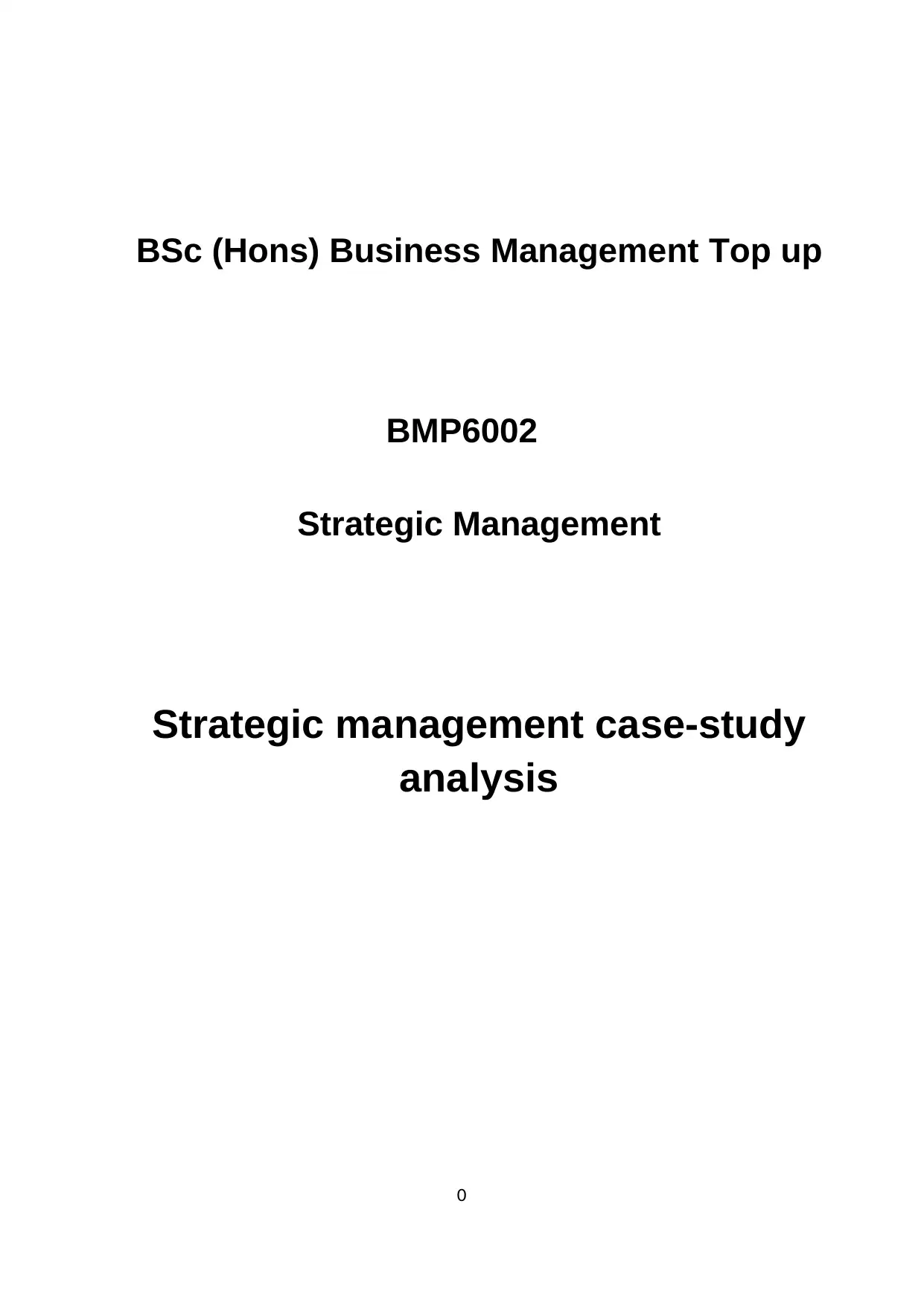
BSc (Hons) Business Management Top up
BMP6002
Strategic Management
Strategic management case-study
analysis
0
BMP6002
Strategic Management
Strategic management case-study
analysis
0
Paraphrase This Document
Need a fresh take? Get an instant paraphrase of this document with our AI Paraphraser
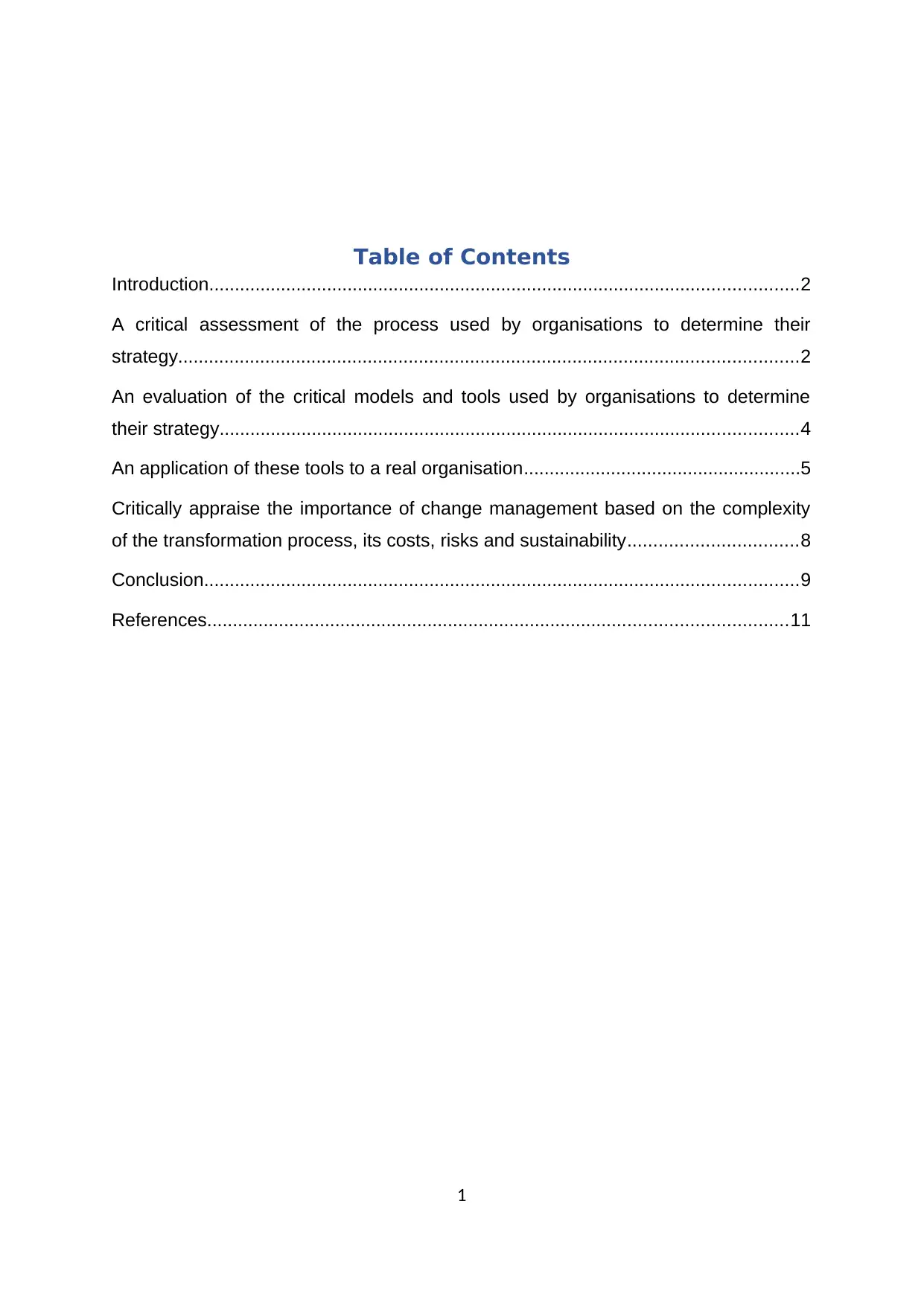
Table of Contents
Introduction...................................................................................................................2
A critical assessment of the process used by organisations to determine their
strategy.........................................................................................................................2
An evaluation of the critical models and tools used by organisations to determine
their strategy.................................................................................................................4
An application of these tools to a real organisation......................................................5
Critically appraise the importance of change management based on the complexity
of the transformation process, its costs, risks and sustainability.................................8
Conclusion....................................................................................................................9
References.................................................................................................................11
1
Introduction...................................................................................................................2
A critical assessment of the process used by organisations to determine their
strategy.........................................................................................................................2
An evaluation of the critical models and tools used by organisations to determine
their strategy.................................................................................................................4
An application of these tools to a real organisation......................................................5
Critically appraise the importance of change management based on the complexity
of the transformation process, its costs, risks and sustainability.................................8
Conclusion....................................................................................................................9
References.................................................................................................................11
1
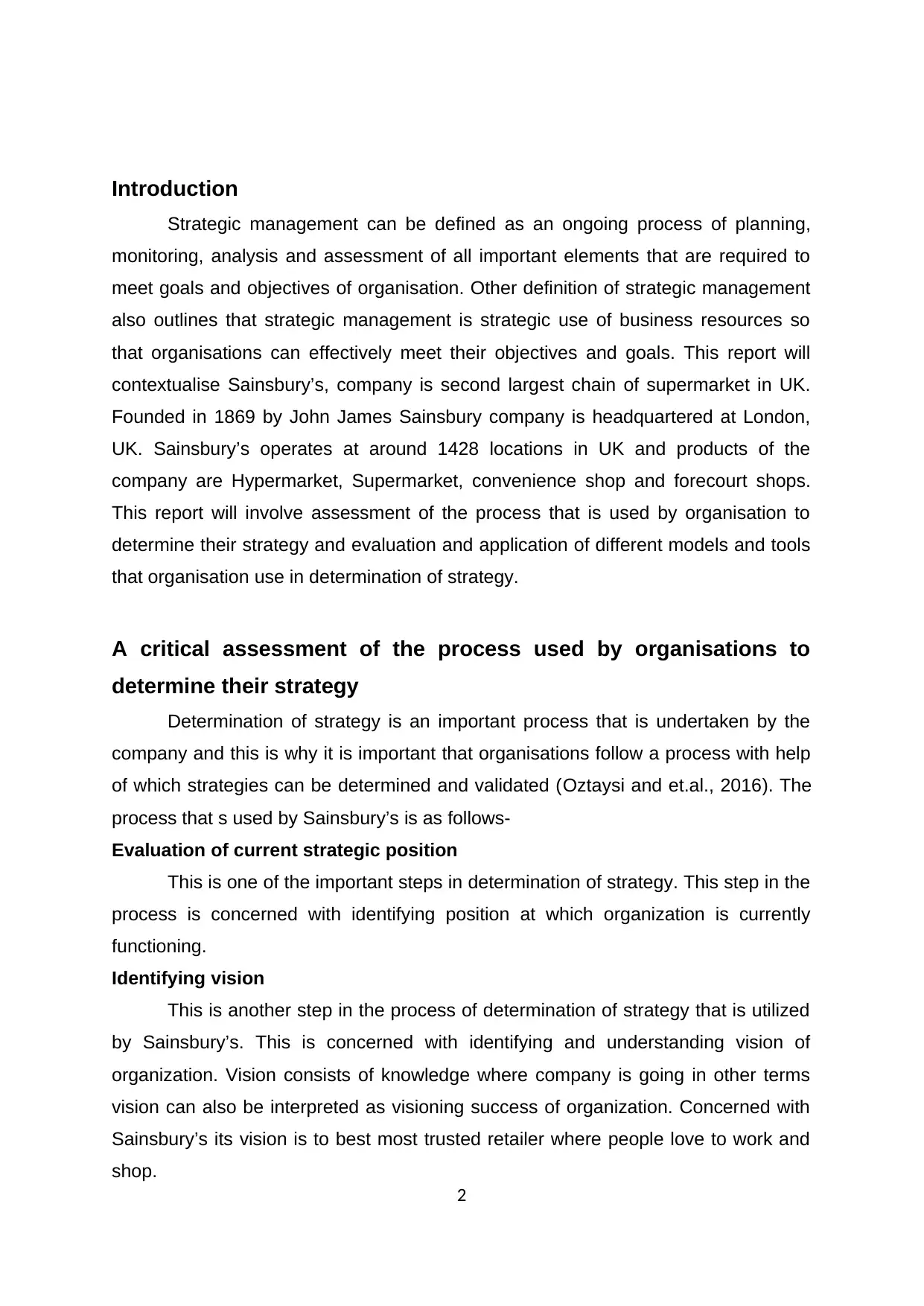
Introduction
Strategic management can be defined as an ongoing process of planning,
monitoring, analysis and assessment of all important elements that are required to
meet goals and objectives of organisation. Other definition of strategic management
also outlines that strategic management is strategic use of business resources so
that organisations can effectively meet their objectives and goals. This report will
contextualise Sainsbury’s, company is second largest chain of supermarket in UK.
Founded in 1869 by John James Sainsbury company is headquartered at London,
UK. Sainsbury’s operates at around 1428 locations in UK and products of the
company are Hypermarket, Supermarket, convenience shop and forecourt shops.
This report will involve assessment of the process that is used by organisation to
determine their strategy and evaluation and application of different models and tools
that organisation use in determination of strategy.
A critical assessment of the process used by organisations to
determine their strategy
Determination of strategy is an important process that is undertaken by the
company and this is why it is important that organisations follow a process with help
of which strategies can be determined and validated (Oztaysi and et.al., 2016). The
process that s used by Sainsbury’s is as follows-
Evaluation of current strategic position
This is one of the important steps in determination of strategy. This step in the
process is concerned with identifying position at which organization is currently
functioning.
Identifying vision
This is another step in the process of determination of strategy that is utilized
by Sainsbury’s. This is concerned with identifying and understanding vision of
organization. Vision consists of knowledge where company is going in other terms
vision can also be interpreted as visioning success of organization. Concerned with
Sainsbury’s its vision is to best most trusted retailer where people love to work and
shop.
2
Strategic management can be defined as an ongoing process of planning,
monitoring, analysis and assessment of all important elements that are required to
meet goals and objectives of organisation. Other definition of strategic management
also outlines that strategic management is strategic use of business resources so
that organisations can effectively meet their objectives and goals. This report will
contextualise Sainsbury’s, company is second largest chain of supermarket in UK.
Founded in 1869 by John James Sainsbury company is headquartered at London,
UK. Sainsbury’s operates at around 1428 locations in UK and products of the
company are Hypermarket, Supermarket, convenience shop and forecourt shops.
This report will involve assessment of the process that is used by organisation to
determine their strategy and evaluation and application of different models and tools
that organisation use in determination of strategy.
A critical assessment of the process used by organisations to
determine their strategy
Determination of strategy is an important process that is undertaken by the
company and this is why it is important that organisations follow a process with help
of which strategies can be determined and validated (Oztaysi and et.al., 2016). The
process that s used by Sainsbury’s is as follows-
Evaluation of current strategic position
This is one of the important steps in determination of strategy. This step in the
process is concerned with identifying position at which organization is currently
functioning.
Identifying vision
This is another step in the process of determination of strategy that is utilized
by Sainsbury’s. This is concerned with identifying and understanding vision of
organization. Vision consists of knowledge where company is going in other terms
vision can also be interpreted as visioning success of organization. Concerned with
Sainsbury’s its vision is to best most trusted retailer where people love to work and
shop.
2
⊘ This is a preview!⊘
Do you want full access?
Subscribe today to unlock all pages.

Trusted by 1+ million students worldwide
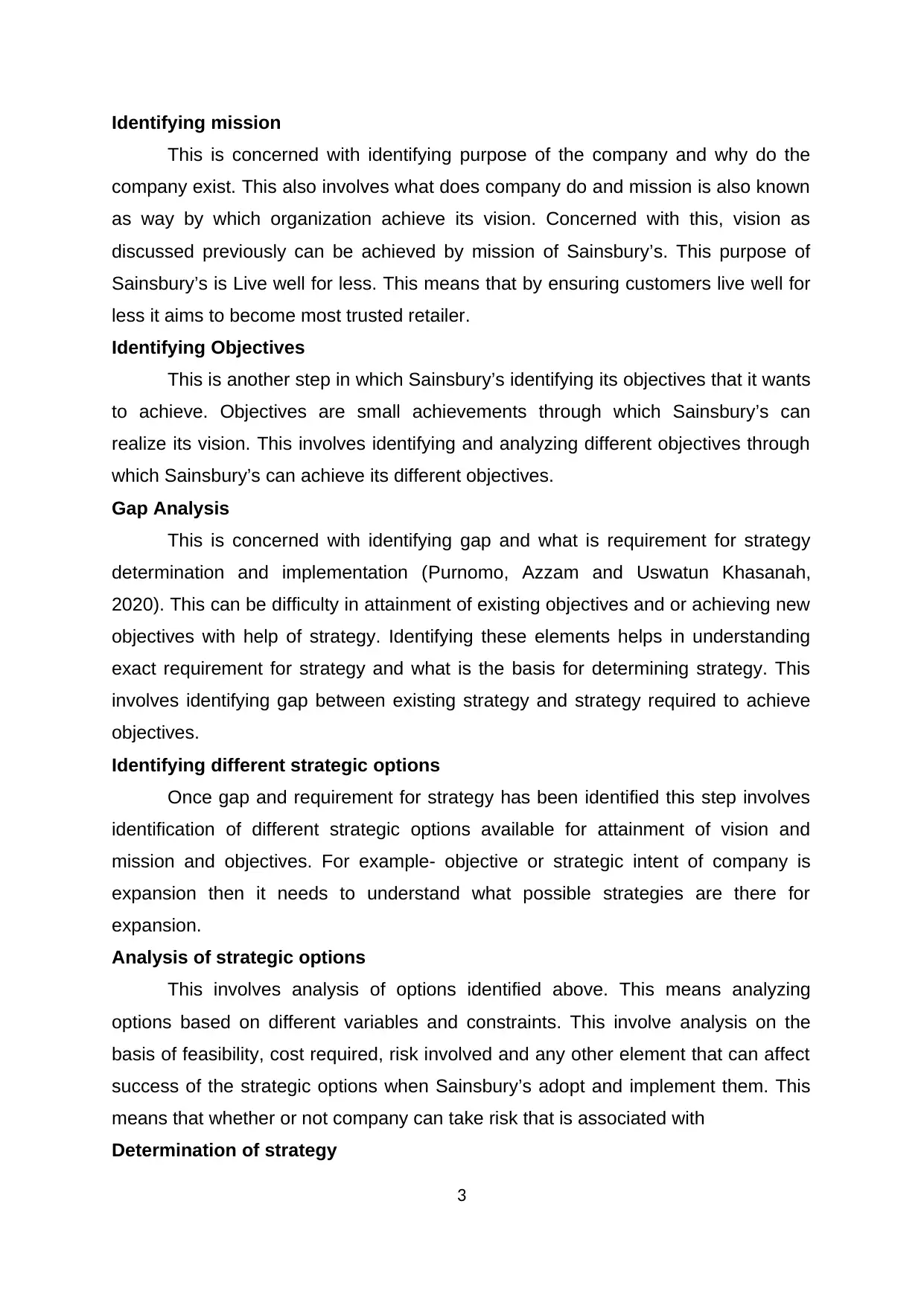
Identifying mission
This is concerned with identifying purpose of the company and why do the
company exist. This also involves what does company do and mission is also known
as way by which organization achieve its vision. Concerned with this, vision as
discussed previously can be achieved by mission of Sainsbury’s. This purpose of
Sainsbury’s is Live well for less. This means that by ensuring customers live well for
less it aims to become most trusted retailer.
Identifying Objectives
This is another step in which Sainsbury’s identifying its objectives that it wants
to achieve. Objectives are small achievements through which Sainsbury’s can
realize its vision. This involves identifying and analyzing different objectives through
which Sainsbury’s can achieve its different objectives.
Gap Analysis
This is concerned with identifying gap and what is requirement for strategy
determination and implementation (Purnomo, Azzam and Uswatun Khasanah,
2020). This can be difficulty in attainment of existing objectives and or achieving new
objectives with help of strategy. Identifying these elements helps in understanding
exact requirement for strategy and what is the basis for determining strategy. This
involves identifying gap between existing strategy and strategy required to achieve
objectives.
Identifying different strategic options
Once gap and requirement for strategy has been identified this step involves
identification of different strategic options available for attainment of vision and
mission and objectives. For example- objective or strategic intent of company is
expansion then it needs to understand what possible strategies are there for
expansion.
Analysis of strategic options
This involves analysis of options identified above. This means analyzing
options based on different variables and constraints. This involve analysis on the
basis of feasibility, cost required, risk involved and any other element that can affect
success of the strategic options when Sainsbury’s adopt and implement them. This
means that whether or not company can take risk that is associated with
Determination of strategy
3
This is concerned with identifying purpose of the company and why do the
company exist. This also involves what does company do and mission is also known
as way by which organization achieve its vision. Concerned with this, vision as
discussed previously can be achieved by mission of Sainsbury’s. This purpose of
Sainsbury’s is Live well for less. This means that by ensuring customers live well for
less it aims to become most trusted retailer.
Identifying Objectives
This is another step in which Sainsbury’s identifying its objectives that it wants
to achieve. Objectives are small achievements through which Sainsbury’s can
realize its vision. This involves identifying and analyzing different objectives through
which Sainsbury’s can achieve its different objectives.
Gap Analysis
This is concerned with identifying gap and what is requirement for strategy
determination and implementation (Purnomo, Azzam and Uswatun Khasanah,
2020). This can be difficulty in attainment of existing objectives and or achieving new
objectives with help of strategy. Identifying these elements helps in understanding
exact requirement for strategy and what is the basis for determining strategy. This
involves identifying gap between existing strategy and strategy required to achieve
objectives.
Identifying different strategic options
Once gap and requirement for strategy has been identified this step involves
identification of different strategic options available for attainment of vision and
mission and objectives. For example- objective or strategic intent of company is
expansion then it needs to understand what possible strategies are there for
expansion.
Analysis of strategic options
This involves analysis of options identified above. This means analyzing
options based on different variables and constraints. This involve analysis on the
basis of feasibility, cost required, risk involved and any other element that can affect
success of the strategic options when Sainsbury’s adopt and implement them. This
means that whether or not company can take risk that is associated with
Determination of strategy
3
Paraphrase This Document
Need a fresh take? Get an instant paraphrase of this document with our AI Paraphraser
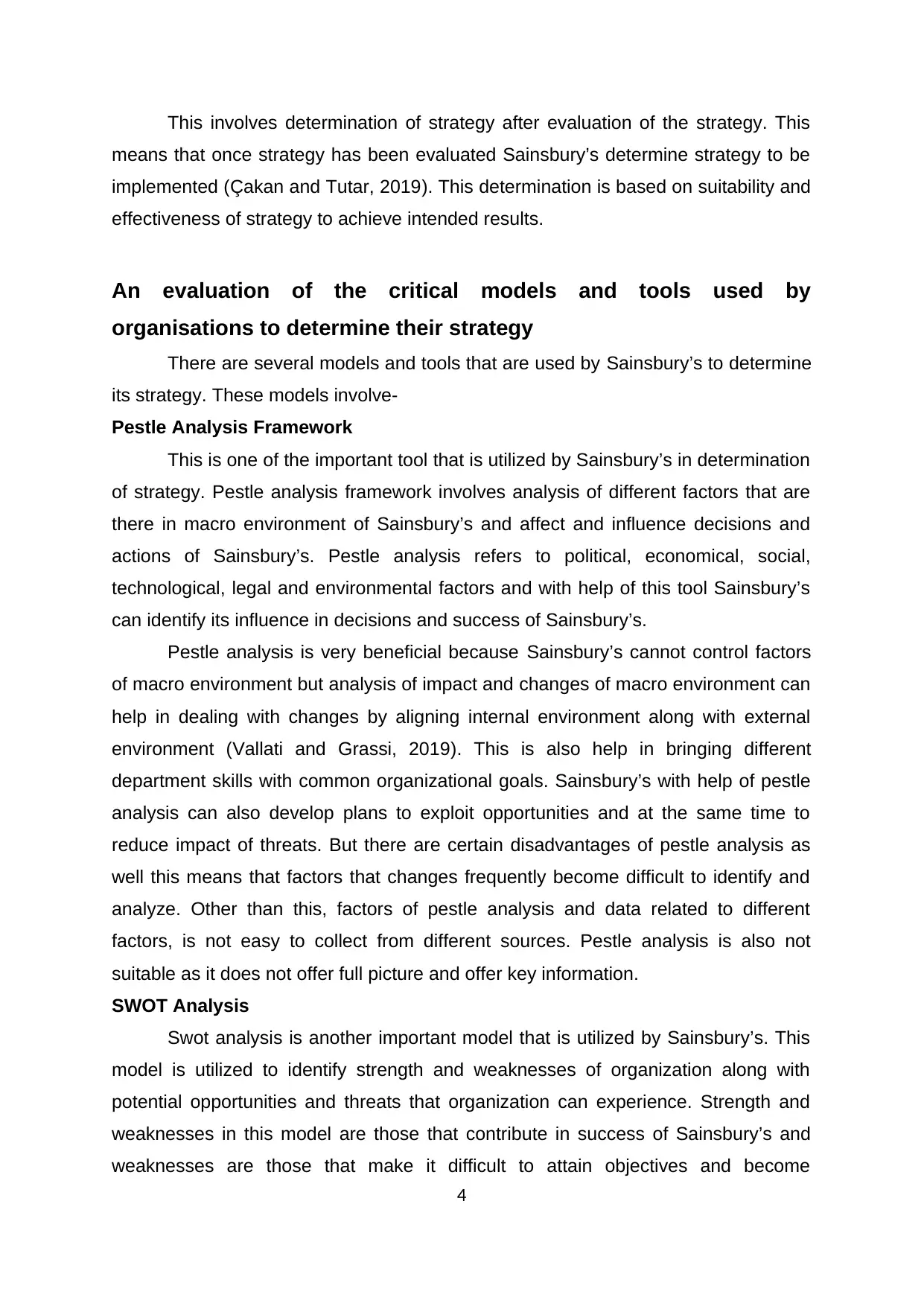
This involves determination of strategy after evaluation of the strategy. This
means that once strategy has been evaluated Sainsbury’s determine strategy to be
implemented (Çakan and Tutar, 2019). This determination is based on suitability and
effectiveness of strategy to achieve intended results.
An evaluation of the critical models and tools used by
organisations to determine their strategy
There are several models and tools that are used by Sainsbury’s to determine
its strategy. These models involve-
Pestle Analysis Framework
This is one of the important tool that is utilized by Sainsbury’s in determination
of strategy. Pestle analysis framework involves analysis of different factors that are
there in macro environment of Sainsbury’s and affect and influence decisions and
actions of Sainsbury’s. Pestle analysis refers to political, economical, social,
technological, legal and environmental factors and with help of this tool Sainsbury’s
can identify its influence in decisions and success of Sainsbury’s.
Pestle analysis is very beneficial because Sainsbury’s cannot control factors
of macro environment but analysis of impact and changes of macro environment can
help in dealing with changes by aligning internal environment along with external
environment (Vallati and Grassi, 2019). This is also help in bringing different
department skills with common organizational goals. Sainsbury’s with help of pestle
analysis can also develop plans to exploit opportunities and at the same time to
reduce impact of threats. But there are certain disadvantages of pestle analysis as
well this means that factors that changes frequently become difficult to identify and
analyze. Other than this, factors of pestle analysis and data related to different
factors, is not easy to collect from different sources. Pestle analysis is also not
suitable as it does not offer full picture and offer key information.
SWOT Analysis
Swot analysis is another important model that is utilized by Sainsbury’s. This
model is utilized to identify strength and weaknesses of organization along with
potential opportunities and threats that organization can experience. Strength and
weaknesses in this model are those that contribute in success of Sainsbury’s and
weaknesses are those that make it difficult to attain objectives and become
4
means that once strategy has been evaluated Sainsbury’s determine strategy to be
implemented (Çakan and Tutar, 2019). This determination is based on suitability and
effectiveness of strategy to achieve intended results.
An evaluation of the critical models and tools used by
organisations to determine their strategy
There are several models and tools that are used by Sainsbury’s to determine
its strategy. These models involve-
Pestle Analysis Framework
This is one of the important tool that is utilized by Sainsbury’s in determination
of strategy. Pestle analysis framework involves analysis of different factors that are
there in macro environment of Sainsbury’s and affect and influence decisions and
actions of Sainsbury’s. Pestle analysis refers to political, economical, social,
technological, legal and environmental factors and with help of this tool Sainsbury’s
can identify its influence in decisions and success of Sainsbury’s.
Pestle analysis is very beneficial because Sainsbury’s cannot control factors
of macro environment but analysis of impact and changes of macro environment can
help in dealing with changes by aligning internal environment along with external
environment (Vallati and Grassi, 2019). This is also help in bringing different
department skills with common organizational goals. Sainsbury’s with help of pestle
analysis can also develop plans to exploit opportunities and at the same time to
reduce impact of threats. But there are certain disadvantages of pestle analysis as
well this means that factors that changes frequently become difficult to identify and
analyze. Other than this, factors of pestle analysis and data related to different
factors, is not easy to collect from different sources. Pestle analysis is also not
suitable as it does not offer full picture and offer key information.
SWOT Analysis
Swot analysis is another important model that is utilized by Sainsbury’s. This
model is utilized to identify strength and weaknesses of organization along with
potential opportunities and threats that organization can experience. Strength and
weaknesses in this model are those that contribute in success of Sainsbury’s and
weaknesses are those that make it difficult to attain objectives and become
4
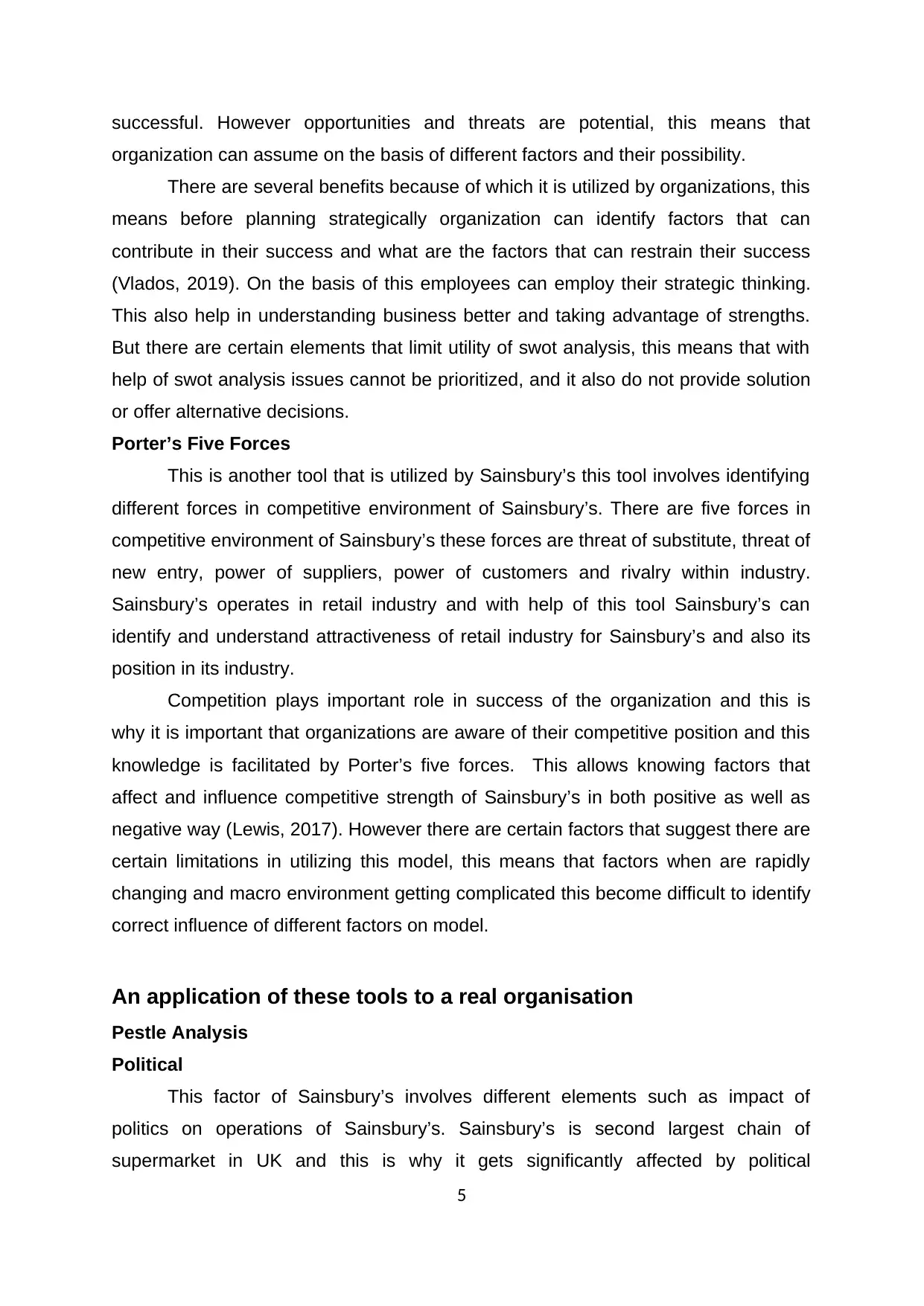
successful. However opportunities and threats are potential, this means that
organization can assume on the basis of different factors and their possibility.
There are several benefits because of which it is utilized by organizations, this
means before planning strategically organization can identify factors that can
contribute in their success and what are the factors that can restrain their success
(Vlados, 2019). On the basis of this employees can employ their strategic thinking.
This also help in understanding business better and taking advantage of strengths.
But there are certain elements that limit utility of swot analysis, this means that with
help of swot analysis issues cannot be prioritized, and it also do not provide solution
or offer alternative decisions.
Porter’s Five Forces
This is another tool that is utilized by Sainsbury’s this tool involves identifying
different forces in competitive environment of Sainsbury’s. There are five forces in
competitive environment of Sainsbury’s these forces are threat of substitute, threat of
new entry, power of suppliers, power of customers and rivalry within industry.
Sainsbury’s operates in retail industry and with help of this tool Sainsbury’s can
identify and understand attractiveness of retail industry for Sainsbury’s and also its
position in its industry.
Competition plays important role in success of the organization and this is
why it is important that organizations are aware of their competitive position and this
knowledge is facilitated by Porter’s five forces. This allows knowing factors that
affect and influence competitive strength of Sainsbury’s in both positive as well as
negative way (Lewis, 2017). However there are certain factors that suggest there are
certain limitations in utilizing this model, this means that factors when are rapidly
changing and macro environment getting complicated this become difficult to identify
correct influence of different factors on model.
An application of these tools to a real organisation
Pestle Analysis
Political
This factor of Sainsbury’s involves different elements such as impact of
politics on operations of Sainsbury’s. Sainsbury’s is second largest chain of
supermarket in UK and this is why it gets significantly affected by political
5
organization can assume on the basis of different factors and their possibility.
There are several benefits because of which it is utilized by organizations, this
means before planning strategically organization can identify factors that can
contribute in their success and what are the factors that can restrain their success
(Vlados, 2019). On the basis of this employees can employ their strategic thinking.
This also help in understanding business better and taking advantage of strengths.
But there are certain elements that limit utility of swot analysis, this means that with
help of swot analysis issues cannot be prioritized, and it also do not provide solution
or offer alternative decisions.
Porter’s Five Forces
This is another tool that is utilized by Sainsbury’s this tool involves identifying
different forces in competitive environment of Sainsbury’s. There are five forces in
competitive environment of Sainsbury’s these forces are threat of substitute, threat of
new entry, power of suppliers, power of customers and rivalry within industry.
Sainsbury’s operates in retail industry and with help of this tool Sainsbury’s can
identify and understand attractiveness of retail industry for Sainsbury’s and also its
position in its industry.
Competition plays important role in success of the organization and this is
why it is important that organizations are aware of their competitive position and this
knowledge is facilitated by Porter’s five forces. This allows knowing factors that
affect and influence competitive strength of Sainsbury’s in both positive as well as
negative way (Lewis, 2017). However there are certain factors that suggest there are
certain limitations in utilizing this model, this means that factors when are rapidly
changing and macro environment getting complicated this become difficult to identify
correct influence of different factors on model.
An application of these tools to a real organisation
Pestle Analysis
Political
This factor of Sainsbury’s involves different elements such as impact of
politics on operations of Sainsbury’s. Sainsbury’s is second largest chain of
supermarket in UK and this is why it gets significantly affected by political
5
⊘ This is a preview!⊘
Do you want full access?
Subscribe today to unlock all pages.

Trusted by 1+ million students worldwide
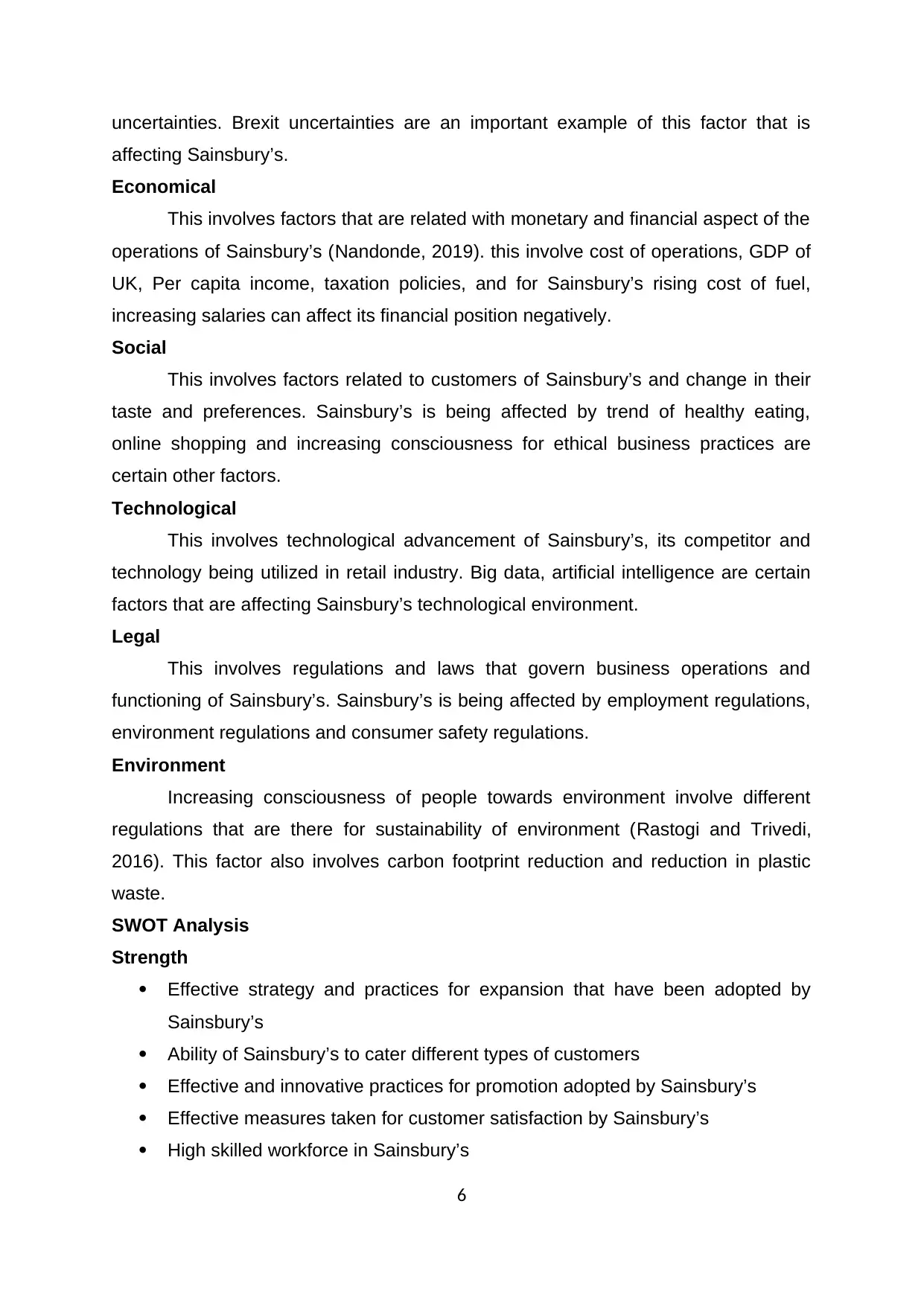
uncertainties. Brexit uncertainties are an important example of this factor that is
affecting Sainsbury’s.
Economical
This involves factors that are related with monetary and financial aspect of the
operations of Sainsbury’s (Nandonde, 2019). this involve cost of operations, GDP of
UK, Per capita income, taxation policies, and for Sainsbury’s rising cost of fuel,
increasing salaries can affect its financial position negatively.
Social
This involves factors related to customers of Sainsbury’s and change in their
taste and preferences. Sainsbury’s is being affected by trend of healthy eating,
online shopping and increasing consciousness for ethical business practices are
certain other factors.
Technological
This involves technological advancement of Sainsbury’s, its competitor and
technology being utilized in retail industry. Big data, artificial intelligence are certain
factors that are affecting Sainsbury’s technological environment.
Legal
This involves regulations and laws that govern business operations and
functioning of Sainsbury’s. Sainsbury’s is being affected by employment regulations,
environment regulations and consumer safety regulations.
Environment
Increasing consciousness of people towards environment involve different
regulations that are there for sustainability of environment (Rastogi and Trivedi,
2016). This factor also involves carbon footprint reduction and reduction in plastic
waste.
SWOT Analysis
Strength
Effective strategy and practices for expansion that have been adopted by
Sainsbury’s
Ability of Sainsbury’s to cater different types of customers
Effective and innovative practices for promotion adopted by Sainsbury’s
Effective measures taken for customer satisfaction by Sainsbury’s
High skilled workforce in Sainsbury’s
6
affecting Sainsbury’s.
Economical
This involves factors that are related with monetary and financial aspect of the
operations of Sainsbury’s (Nandonde, 2019). this involve cost of operations, GDP of
UK, Per capita income, taxation policies, and for Sainsbury’s rising cost of fuel,
increasing salaries can affect its financial position negatively.
Social
This involves factors related to customers of Sainsbury’s and change in their
taste and preferences. Sainsbury’s is being affected by trend of healthy eating,
online shopping and increasing consciousness for ethical business practices are
certain other factors.
Technological
This involves technological advancement of Sainsbury’s, its competitor and
technology being utilized in retail industry. Big data, artificial intelligence are certain
factors that are affecting Sainsbury’s technological environment.
Legal
This involves regulations and laws that govern business operations and
functioning of Sainsbury’s. Sainsbury’s is being affected by employment regulations,
environment regulations and consumer safety regulations.
Environment
Increasing consciousness of people towards environment involve different
regulations that are there for sustainability of environment (Rastogi and Trivedi,
2016). This factor also involves carbon footprint reduction and reduction in plastic
waste.
SWOT Analysis
Strength
Effective strategy and practices for expansion that have been adopted by
Sainsbury’s
Ability of Sainsbury’s to cater different types of customers
Effective and innovative practices for promotion adopted by Sainsbury’s
Effective measures taken for customer satisfaction by Sainsbury’s
High skilled workforce in Sainsbury’s
6
Paraphrase This Document
Need a fresh take? Get an instant paraphrase of this document with our AI Paraphraser
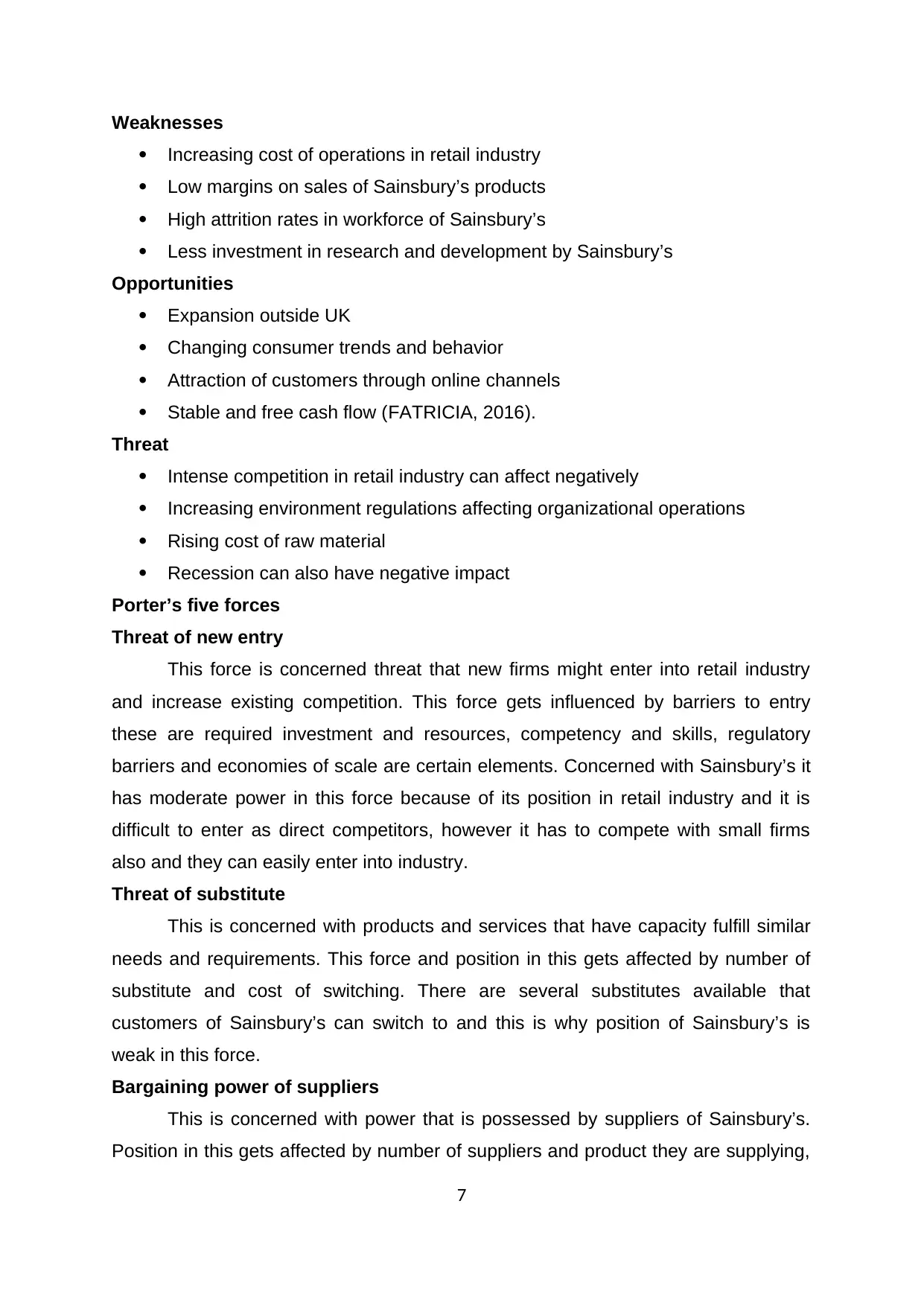
Weaknesses
Increasing cost of operations in retail industry
Low margins on sales of Sainsbury’s products
High attrition rates in workforce of Sainsbury’s
Less investment in research and development by Sainsbury’s
Opportunities
Expansion outside UK
Changing consumer trends and behavior
Attraction of customers through online channels
Stable and free cash flow (FATRICIA, 2016).
Threat
Intense competition in retail industry can affect negatively
Increasing environment regulations affecting organizational operations
Rising cost of raw material
Recession can also have negative impact
Porter’s five forces
Threat of new entry
This force is concerned threat that new firms might enter into retail industry
and increase existing competition. This force gets influenced by barriers to entry
these are required investment and resources, competency and skills, regulatory
barriers and economies of scale are certain elements. Concerned with Sainsbury’s it
has moderate power in this force because of its position in retail industry and it is
difficult to enter as direct competitors, however it has to compete with small firms
also and they can easily enter into industry.
Threat of substitute
This is concerned with products and services that have capacity fulfill similar
needs and requirements. This force and position in this gets affected by number of
substitute and cost of switching. There are several substitutes available that
customers of Sainsbury’s can switch to and this is why position of Sainsbury’s is
weak in this force.
Bargaining power of suppliers
This is concerned with power that is possessed by suppliers of Sainsbury’s.
Position in this gets affected by number of suppliers and product they are supplying,
7
Increasing cost of operations in retail industry
Low margins on sales of Sainsbury’s products
High attrition rates in workforce of Sainsbury’s
Less investment in research and development by Sainsbury’s
Opportunities
Expansion outside UK
Changing consumer trends and behavior
Attraction of customers through online channels
Stable and free cash flow (FATRICIA, 2016).
Threat
Intense competition in retail industry can affect negatively
Increasing environment regulations affecting organizational operations
Rising cost of raw material
Recession can also have negative impact
Porter’s five forces
Threat of new entry
This force is concerned threat that new firms might enter into retail industry
and increase existing competition. This force gets influenced by barriers to entry
these are required investment and resources, competency and skills, regulatory
barriers and economies of scale are certain elements. Concerned with Sainsbury’s it
has moderate power in this force because of its position in retail industry and it is
difficult to enter as direct competitors, however it has to compete with small firms
also and they can easily enter into industry.
Threat of substitute
This is concerned with products and services that have capacity fulfill similar
needs and requirements. This force and position in this gets affected by number of
substitute and cost of switching. There are several substitutes available that
customers of Sainsbury’s can switch to and this is why position of Sainsbury’s is
weak in this force.
Bargaining power of suppliers
This is concerned with power that is possessed by suppliers of Sainsbury’s.
Position in this gets affected by number of suppliers and product they are supplying,
7
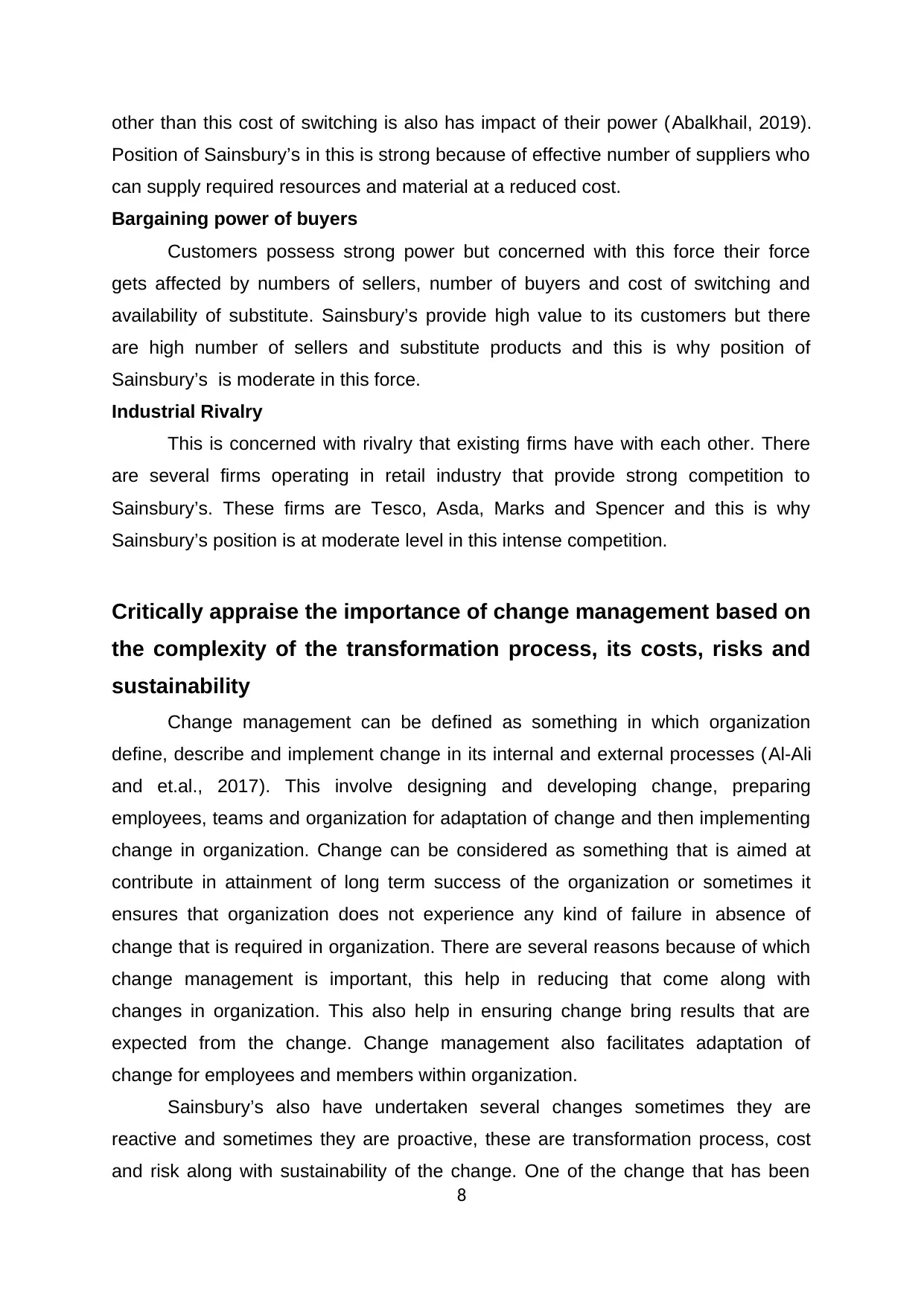
other than this cost of switching is also has impact of their power (Abalkhail, 2019).
Position of Sainsbury’s in this is strong because of effective number of suppliers who
can supply required resources and material at a reduced cost.
Bargaining power of buyers
Customers possess strong power but concerned with this force their force
gets affected by numbers of sellers, number of buyers and cost of switching and
availability of substitute. Sainsbury’s provide high value to its customers but there
are high number of sellers and substitute products and this is why position of
Sainsbury’s is moderate in this force.
Industrial Rivalry
This is concerned with rivalry that existing firms have with each other. There
are several firms operating in retail industry that provide strong competition to
Sainsbury’s. These firms are Tesco, Asda, Marks and Spencer and this is why
Sainsbury’s position is at moderate level in this intense competition.
Critically appraise the importance of change management based on
the complexity of the transformation process, its costs, risks and
sustainability
Change management can be defined as something in which organization
define, describe and implement change in its internal and external processes (Al-Ali
and et.al., 2017). This involve designing and developing change, preparing
employees, teams and organization for adaptation of change and then implementing
change in organization. Change can be considered as something that is aimed at
contribute in attainment of long term success of the organization or sometimes it
ensures that organization does not experience any kind of failure in absence of
change that is required in organization. There are several reasons because of which
change management is important, this help in reducing that come along with
changes in organization. This also help in ensuring change bring results that are
expected from the change. Change management also facilitates adaptation of
change for employees and members within organization.
Sainsbury’s also have undertaken several changes sometimes they are
reactive and sometimes they are proactive, these are transformation process, cost
and risk along with sustainability of the change. One of the change that has been
8
Position of Sainsbury’s in this is strong because of effective number of suppliers who
can supply required resources and material at a reduced cost.
Bargaining power of buyers
Customers possess strong power but concerned with this force their force
gets affected by numbers of sellers, number of buyers and cost of switching and
availability of substitute. Sainsbury’s provide high value to its customers but there
are high number of sellers and substitute products and this is why position of
Sainsbury’s is moderate in this force.
Industrial Rivalry
This is concerned with rivalry that existing firms have with each other. There
are several firms operating in retail industry that provide strong competition to
Sainsbury’s. These firms are Tesco, Asda, Marks and Spencer and this is why
Sainsbury’s position is at moderate level in this intense competition.
Critically appraise the importance of change management based on
the complexity of the transformation process, its costs, risks and
sustainability
Change management can be defined as something in which organization
define, describe and implement change in its internal and external processes (Al-Ali
and et.al., 2017). This involve designing and developing change, preparing
employees, teams and organization for adaptation of change and then implementing
change in organization. Change can be considered as something that is aimed at
contribute in attainment of long term success of the organization or sometimes it
ensures that organization does not experience any kind of failure in absence of
change that is required in organization. There are several reasons because of which
change management is important, this help in reducing that come along with
changes in organization. This also help in ensuring change bring results that are
expected from the change. Change management also facilitates adaptation of
change for employees and members within organization.
Sainsbury’s also have undertaken several changes sometimes they are
reactive and sometimes they are proactive, these are transformation process, cost
and risk along with sustainability of the change. One of the change that has been
8
⊘ This is a preview!⊘
Do you want full access?
Subscribe today to unlock all pages.

Trusted by 1+ million students worldwide
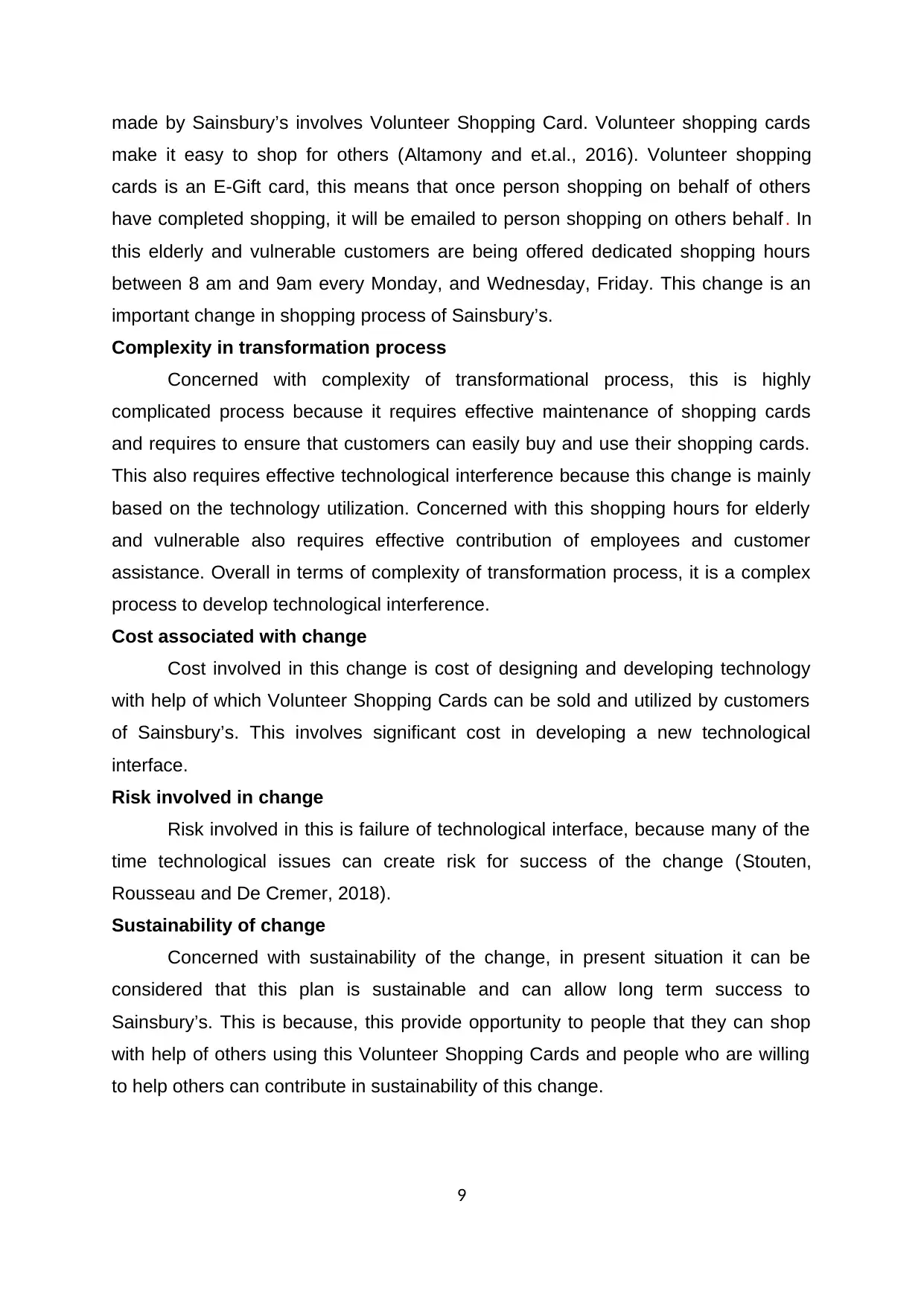
made by Sainsbury’s involves Volunteer Shopping Card. Volunteer shopping cards
make it easy to shop for others (Altamony and et.al., 2016). Volunteer shopping
cards is an E-Gift card, this means that once person shopping on behalf of others
have completed shopping, it will be emailed to person shopping on others behalf . In
this elderly and vulnerable customers are being offered dedicated shopping hours
between 8 am and 9am every Monday, and Wednesday, Friday. This change is an
important change in shopping process of Sainsbury’s.
Complexity in transformation process
Concerned with complexity of transformational process, this is highly
complicated process because it requires effective maintenance of shopping cards
and requires to ensure that customers can easily buy and use their shopping cards.
This also requires effective technological interference because this change is mainly
based on the technology utilization. Concerned with this shopping hours for elderly
and vulnerable also requires effective contribution of employees and customer
assistance. Overall in terms of complexity of transformation process, it is a complex
process to develop technological interference.
Cost associated with change
Cost involved in this change is cost of designing and developing technology
with help of which Volunteer Shopping Cards can be sold and utilized by customers
of Sainsbury’s. This involves significant cost in developing a new technological
interface.
Risk involved in change
Risk involved in this is failure of technological interface, because many of the
time technological issues can create risk for success of the change (Stouten,
Rousseau and De Cremer, 2018).
Sustainability of change
Concerned with sustainability of the change, in present situation it can be
considered that this plan is sustainable and can allow long term success to
Sainsbury’s. This is because, this provide opportunity to people that they can shop
with help of others using this Volunteer Shopping Cards and people who are willing
to help others can contribute in sustainability of this change.
9
make it easy to shop for others (Altamony and et.al., 2016). Volunteer shopping
cards is an E-Gift card, this means that once person shopping on behalf of others
have completed shopping, it will be emailed to person shopping on others behalf . In
this elderly and vulnerable customers are being offered dedicated shopping hours
between 8 am and 9am every Monday, and Wednesday, Friday. This change is an
important change in shopping process of Sainsbury’s.
Complexity in transformation process
Concerned with complexity of transformational process, this is highly
complicated process because it requires effective maintenance of shopping cards
and requires to ensure that customers can easily buy and use their shopping cards.
This also requires effective technological interference because this change is mainly
based on the technology utilization. Concerned with this shopping hours for elderly
and vulnerable also requires effective contribution of employees and customer
assistance. Overall in terms of complexity of transformation process, it is a complex
process to develop technological interference.
Cost associated with change
Cost involved in this change is cost of designing and developing technology
with help of which Volunteer Shopping Cards can be sold and utilized by customers
of Sainsbury’s. This involves significant cost in developing a new technological
interface.
Risk involved in change
Risk involved in this is failure of technological interface, because many of the
time technological issues can create risk for success of the change (Stouten,
Rousseau and De Cremer, 2018).
Sustainability of change
Concerned with sustainability of the change, in present situation it can be
considered that this plan is sustainable and can allow long term success to
Sainsbury’s. This is because, this provide opportunity to people that they can shop
with help of others using this Volunteer Shopping Cards and people who are willing
to help others can contribute in sustainability of this change.
9
Paraphrase This Document
Need a fresh take? Get an instant paraphrase of this document with our AI Paraphraser
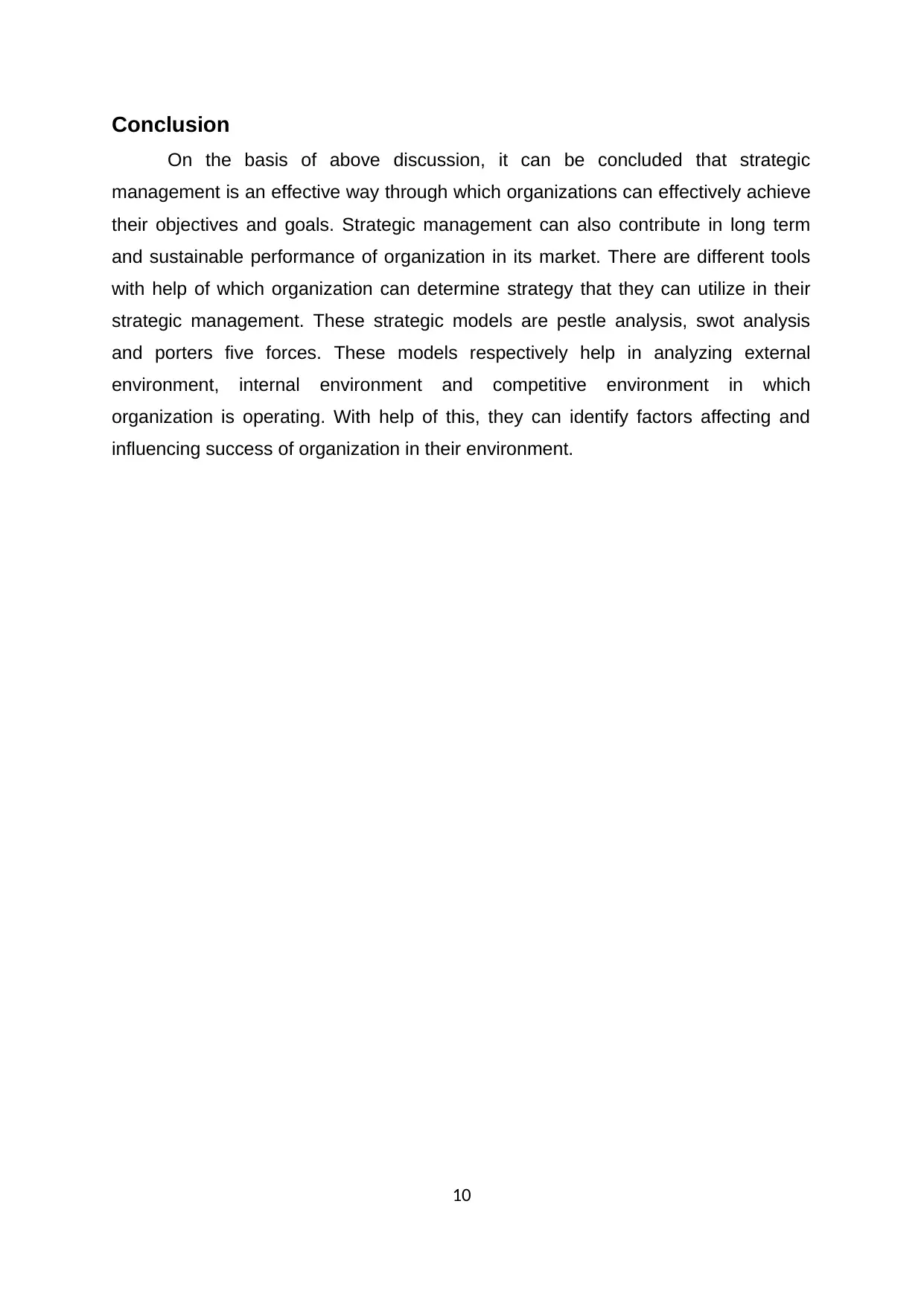
Conclusion
On the basis of above discussion, it can be concluded that strategic
management is an effective way through which organizations can effectively achieve
their objectives and goals. Strategic management can also contribute in long term
and sustainable performance of organization in its market. There are different tools
with help of which organization can determine strategy that they can utilize in their
strategic management. These strategic models are pestle analysis, swot analysis
and porters five forces. These models respectively help in analyzing external
environment, internal environment and competitive environment in which
organization is operating. With help of this, they can identify factors affecting and
influencing success of organization in their environment.
10
On the basis of above discussion, it can be concluded that strategic
management is an effective way through which organizations can effectively achieve
their objectives and goals. Strategic management can also contribute in long term
and sustainable performance of organization in its market. There are different tools
with help of which organization can determine strategy that they can utilize in their
strategic management. These strategic models are pestle analysis, swot analysis
and porters five forces. These models respectively help in analyzing external
environment, internal environment and competitive environment in which
organization is operating. With help of this, they can identify factors affecting and
influencing success of organization in their environment.
10
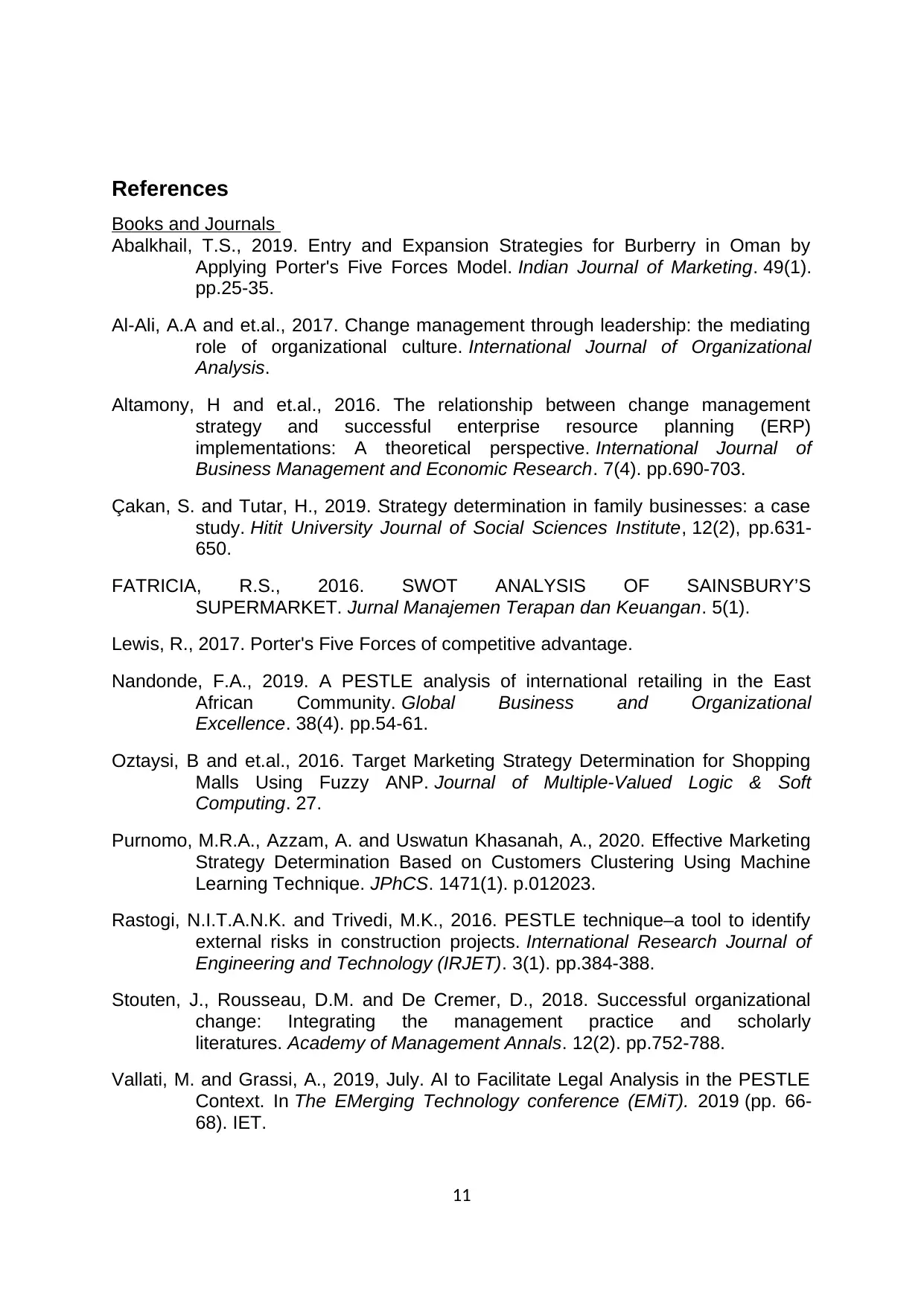
References
Books and Journals
Abalkhail, T.S., 2019. Entry and Expansion Strategies for Burberry in Oman by
Applying Porter's Five Forces Model. Indian Journal of Marketing. 49(1).
pp.25-35.
Al-Ali, A.A and et.al., 2017. Change management through leadership: the mediating
role of organizational culture. International Journal of Organizational
Analysis.
Altamony, H and et.al., 2016. The relationship between change management
strategy and successful enterprise resource planning (ERP)
implementations: A theoretical perspective. International Journal of
Business Management and Economic Research. 7(4). pp.690-703.
Çakan, S. and Tutar, H., 2019. Strategy determination in family businesses: a case
study. Hitit University Journal of Social Sciences Institute, 12(2), pp.631-
650.
FATRICIA, R.S., 2016. SWOT ANALYSIS OF SAINSBURY’S
SUPERMARKET. Jurnal Manajemen Terapan dan Keuangan. 5(1).
Lewis, R., 2017. Porter's Five Forces of competitive advantage.
Nandonde, F.A., 2019. A PESTLE analysis of international retailing in the East
African Community. Global Business and Organizational
Excellence. 38(4). pp.54-61.
Oztaysi, B and et.al., 2016. Target Marketing Strategy Determination for Shopping
Malls Using Fuzzy ANP. Journal of Multiple-Valued Logic & Soft
Computing. 27.
Purnomo, M.R.A., Azzam, A. and Uswatun Khasanah, A., 2020. Effective Marketing
Strategy Determination Based on Customers Clustering Using Machine
Learning Technique. JPhCS. 1471(1). p.012023.
Rastogi, N.I.T.A.N.K. and Trivedi, M.K., 2016. PESTLE technique–a tool to identify
external risks in construction projects. International Research Journal of
Engineering and Technology (IRJET). 3(1). pp.384-388.
Stouten, J., Rousseau, D.M. and De Cremer, D., 2018. Successful organizational
change: Integrating the management practice and scholarly
literatures. Academy of Management Annals. 12(2). pp.752-788.
Vallati, M. and Grassi, A., 2019, July. AI to Facilitate Legal Analysis in the PESTLE
Context. In The EMerging Technology conference (EMiT). 2019 (pp. 66-
68). IET.
11
Books and Journals
Abalkhail, T.S., 2019. Entry and Expansion Strategies for Burberry in Oman by
Applying Porter's Five Forces Model. Indian Journal of Marketing. 49(1).
pp.25-35.
Al-Ali, A.A and et.al., 2017. Change management through leadership: the mediating
role of organizational culture. International Journal of Organizational
Analysis.
Altamony, H and et.al., 2016. The relationship between change management
strategy and successful enterprise resource planning (ERP)
implementations: A theoretical perspective. International Journal of
Business Management and Economic Research. 7(4). pp.690-703.
Çakan, S. and Tutar, H., 2019. Strategy determination in family businesses: a case
study. Hitit University Journal of Social Sciences Institute, 12(2), pp.631-
650.
FATRICIA, R.S., 2016. SWOT ANALYSIS OF SAINSBURY’S
SUPERMARKET. Jurnal Manajemen Terapan dan Keuangan. 5(1).
Lewis, R., 2017. Porter's Five Forces of competitive advantage.
Nandonde, F.A., 2019. A PESTLE analysis of international retailing in the East
African Community. Global Business and Organizational
Excellence. 38(4). pp.54-61.
Oztaysi, B and et.al., 2016. Target Marketing Strategy Determination for Shopping
Malls Using Fuzzy ANP. Journal of Multiple-Valued Logic & Soft
Computing. 27.
Purnomo, M.R.A., Azzam, A. and Uswatun Khasanah, A., 2020. Effective Marketing
Strategy Determination Based on Customers Clustering Using Machine
Learning Technique. JPhCS. 1471(1). p.012023.
Rastogi, N.I.T.A.N.K. and Trivedi, M.K., 2016. PESTLE technique–a tool to identify
external risks in construction projects. International Research Journal of
Engineering and Technology (IRJET). 3(1). pp.384-388.
Stouten, J., Rousseau, D.M. and De Cremer, D., 2018. Successful organizational
change: Integrating the management practice and scholarly
literatures. Academy of Management Annals. 12(2). pp.752-788.
Vallati, M. and Grassi, A., 2019, July. AI to Facilitate Legal Analysis in the PESTLE
Context. In The EMerging Technology conference (EMiT). 2019 (pp. 66-
68). IET.
11
⊘ This is a preview!⊘
Do you want full access?
Subscribe today to unlock all pages.

Trusted by 1+ million students worldwide
1 out of 13
Related Documents
Your All-in-One AI-Powered Toolkit for Academic Success.
+13062052269
info@desklib.com
Available 24*7 on WhatsApp / Email
![[object Object]](/_next/static/media/star-bottom.7253800d.svg)
Unlock your academic potential
Copyright © 2020–2025 A2Z Services. All Rights Reserved. Developed and managed by ZUCOL.





